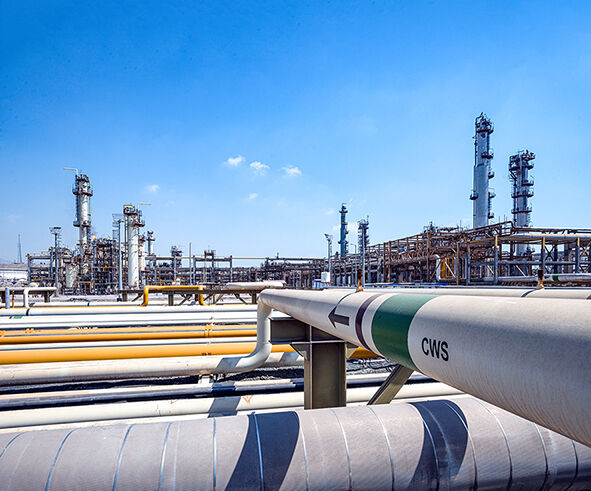Legal obligation
The current refining capacity of the country totals 2.2 mb/d of crude oil and gas condensate, which is planned to reach 3.5 mb/d. This target is expected to be achieved by building new refineries, as well as launching refinery-integrated petrochemical plants. Meantime, upgrading the quality of refined products has become a must in the world due to changes in the consumption paradigm. Meantime, changing the refined products mix and increasing the share of light products by converting heavy products to lighter and middle distillate ones are among issues enshrined in law.
Currently, on average 65 ml/d of fuel oil is produced in the country, constituting about 18% of total refined petroleum products.
The 7th National Economic Development Plan requires “fuel oil” production in the country to be cut by 5% to 49 ml/d. Meantime, in a bid to incentivize refining companies to implement quality upgrade projects, these companies are required by the national budget to allocate 40% of their refining margins to these projects so that they would continue to benefit from a 5% reduction in feedstock prices.
Optimization
In a bid to reduce fuel oil production and subsequently increase the margins of refineries, the Ministry of Petroleum has given the go-ahead for the optimization of 9 refineries. It is said that 13 refinery-integrated petrochemical projects have received licenses, which would be fed with crude oil and gas condensate. Besides, 3 of these projects, named Shahid Soleimani, Morvarid Makran, and Mehr Khalij Fars, have been shortlisted by the Economic Resilience Committee. Currently, for all refineries in the country, quantitative and qualitative upgrade projects have been defined, and engineering studies are now over. For instance, the project to upgrade gasoil quality at the Isfahan refinery is over while other refining projects are 20-100% completed.
Fuel oil projects prioritized
The shift in the pattern of fuel oil consumption in the world has made it obligatory for countries to upgrade the quality of fuel oil. Jalil Salari, the CEO of the National Iranian Oil Refining and Distribution Company (NIORDC), has stressed that in light of the change in the percentage of crude oil recovery, fuel oil quality projects should be prioritized. Fuel oil quality upgrade projects have already become operational at the Bandar Abbas and Shazand oil refineries. The Shiraz refinery is producing 1.3 mb/d of fuel oil and a pilot project is currently under way to boost the quality of this product.
By operating fuel oil quality projects, NIORDC has contributed to the desulfurization process and value-added generation in favor of environmental obligations.
Needle coke
Currently cutting the rate of heavy products output at the Tabriz oil refinery, reducing fuel oil production at the Shiraz oil refinery, building fuel oil desulfurization unit, building CCR units at the Tehran oil refinery, building 81 tb/d desulfurization unit at the Isfahan refinery, building a fuel oil quality unit at the Kermanshah refinery and upgrading the quality of heavy products and delayed coking at the Bandar Abbas refinery is underway. Furthermore, upgrading the quality of gasoil and gasoline at the Shiraz oil refinery, launching the coke petroleum unit and building a distillation unit at the Lavan refinery, building a needle coke production unit at the Shazand refinery and the second phase development of the Abadan refinery is underway.
Project details
Isfahan refinery: Residue hydrotreating unit (RU), desulfurization, and increasing low-sulfur fuel oil by 300,000 tonnes a month, which come online by March 2026.
Abadan refinery: Bottom upgrading studies to reduce fuel oil production and increase the quality of products in line with environmental obligations.
Shiraz refinery: Light naphtha isomerization unit by building a naphtha desulfurization unit and naphtha splitter with 6.5 tb/d capacity; building a new isomerization unit with 5 tb/d capacity to produce Euro-5 gasoline and building a unit to desulfurize middle-distillate products to reach Euro-5 gasoil.
Bandar Abbas refinery: The objective behind upgrading the quality of heavy products at this refinery is to minimize fuel oil production, supply higher-value products to increase the refinery profitability, increase products including diesel fuel in line with international environmental standards, produce oil coke at quality needed for aluminum manufacturing, producing Euro-5 gasoil and gasoline, propane, butane and varieties of solvents as well as base oils. The project is expected to come online in three phases by March 2026.
Shazand refinery: Needle coke production to reduce fuel oil output and produce 95,000 tonnes a year of coke based on national needs. It is expected to come online by 2025 with technical know-how provided by the Research Institute of Petroleum Industry (RIPI).
Tehran refinery: Building heavy naphtha processing units and CCR to reduce benzene content in gasoline and increase Euro-5 gasoline production from the current 6.5 ml/d to 8 ml/d, which is expected to come online by March 2025. Other plans underway at this refinery include a bottom upgrading product and completion of the petrochemical value chain.
Tabriz refinery: Implementing a comprehensive plan to increase gasoline and gasoil production from the current 3.8 ml/d and 7.2 ml/d to 4.9 and 9 ml/d respectively, while minimizing fuel oil production. This project is scheduled for 2026.
Lavan refinery: Building a new vacuum distillation unit and bitumen production to convert residues of the atmospheric distillation tower to higher-value products. This project is expected to become operational by 2025.
Kermanshah refinery: Upgrading the quantity and quality of products to reduce fuel oil sulfur, coke production, hydrotreating of naphtha, and isomerization. This project is scheduled for 2025.
Iran Petroleum


Your Comment